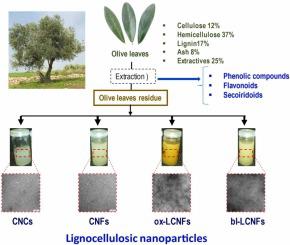Industrial Crops and Products ( IF 5.9 ) Pub Date : 2023-06-08 , DOI: 10.1016/j.indcrop.2023.116996 Ayman Ben Mabrouk , Jean-Luc Putaux , Sami Boufi

|
The olive oil activity generates annually a huge amount of biomass waste from the pruning action of the tree and fruit harvesting, including thin woody branches and leaves. In an effort toward more sustainability in the lignocellulosic biorefinery of olive waste activity, nanocelluloses (NCs) were produced from the solid residues remaining after the extraction of biological active compounds from the leaves. Fractions containing cellulose nanocrystals (CNCs), cellulose nanofibrils (CNFs), and lignin-containing cellulose nanofibrils (LCNFs) were prepared and characterized in terms of morphology, chemical composition, thermal stability, colloidal properties, and crystallinity. The reinforcing capability of the different fractions was evaluated in nanocomposite films made of an acrylic matrix incorporating different NC contents. Dynamic mechanical analysis (DMA) and tensile testing of the films were used to compare the reinforcing effect of the NCs. Although CNCs displayed the highest reinforcing effect based on the weight content, LCNFs and CNFs demonstrated also a reinforcing effect, which is higher when normalized with the cellulose content. Compared to CNFs and CNCs, LCNFs displayed a lower hydrophilic character confirmed by contact angle measurement, and had better thermal stability. This work demonstrated the potential use of the solid waste from olive leaves as a new source for biobased nanoparticles containing lignin, hemicellulose components, and cellulose nanofibrils. Beside the high content in bioactive polyphenol compounds that can be extracted from olive leaves, the conversion of the residual biomass can contribute to increasing the circularity and sustainability of olive oil activity.
中文翻译:

橄榄叶废料的价值化作为含有纤维素纳米材料的馏分的新来源
橄榄油活动每年都会产生大量来自树木修剪和果实收获的生物质废物,包括细木枝和树叶。为了提高橄榄废物活性的木质纤维素生物精炼厂的可持续性,从叶子中提取生物活性化合物后剩余的固体残留物生产纳米纤维素 (NCs)。分数包含制备了纤维素纳米晶体 (CNC)、纤维素纳米原纤维 (CNF) 和含木质素的纤维素纳米原纤维 (LCNF),并在形态、化学成分、热稳定性、胶体性质和结晶度方面对其进行了表征。在由包含不同 NC 含量的丙烯酸基体制成的纳米复合膜中评估了不同部分的增强能力。薄膜的动态机械分析 (DMA) 和拉伸测试用于比较 NC 的增强效果。虽然 CNCs 根据重量含量表现出最高的增强效果,但 LCNF 和 CNF 也表现出增强效果,当用纤维素含量标准化时这种效果更高。与 CNF 和 CNC 相比,LCNF 显示出较低的亲水性,通过接触角测量得到证实,并且具有更好的热稳定性。这项工作证明了潜在的用途来自橄榄叶的固体废物作为含有木质素、半纤维素成分和纤维素纳米原纤维的生物基纳米粒子的新来源。除了可以从橄榄叶中提取的高含量生物活性多酚化合物外,残余生物质的转化有助于提高橄榄油活性的循环性和可持续性。


























 京公网安备 11010802027423号
京公网安备 11010802027423号